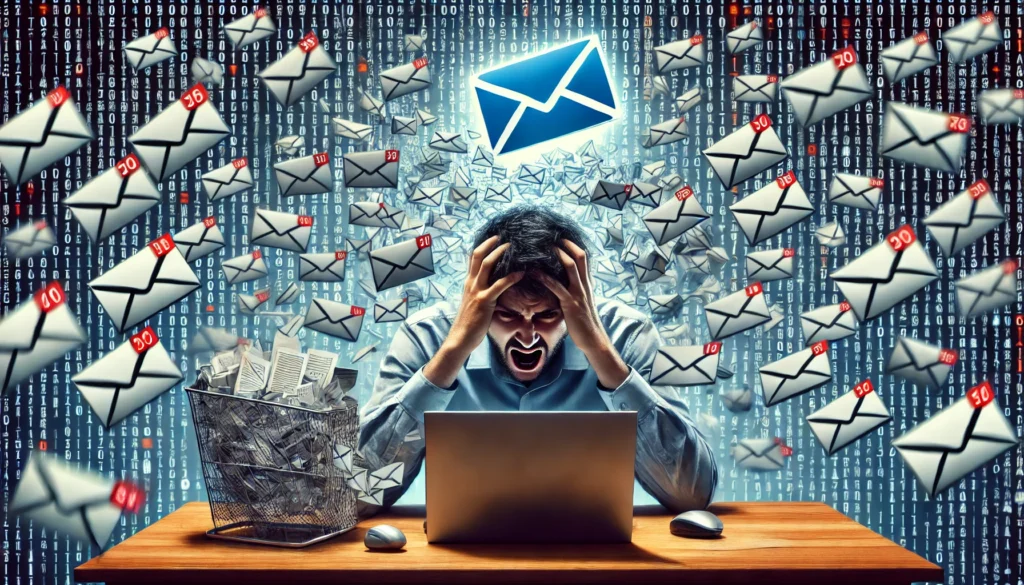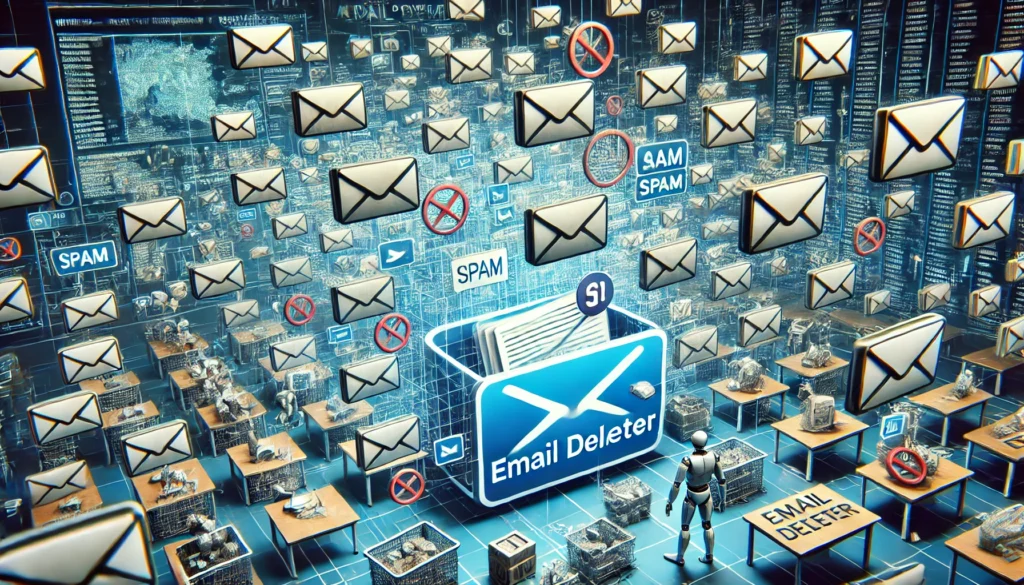Before delving into the strategies for managing spam, it’s essential to understand what spam emails are. Spam, or unsolicited bulk emails, are often sent indiscriminately to large numbers of recipients, typically for advertising, phishing, or spreading malware. The origins of spam can be traced back to the early days of the internet when the lack of regulation made it easy for spammers to exploit email systems.
You may also like: Top Email Deleters for Inbox Management
The Definition of Spam
Spam emails are essentially unsolicited messages sent in bulk. These messages usually have commercial intent, often trying to sell products or services, or worse, to deceive recipients for malicious purposes. Understanding what constitutes spam is the first step in effectively managing it.
Historical Context of Spam
The history of spam dates back to the 1970s, but it wasn’t until the 1990s that it became a pervasive issue. Initially, spam was simply an annoyance, but as technology advanced, so did the techniques used by spammers. This evolution has made spam a persistent problem in the digital era.
Types of Spam Emails
Spam emails come in various forms, including commercial advertising, phishing scams, and malware distribution. Each type has distinct characteristics and poses different risks to users. Recognizing these types can help users better identify and manage them.
The Impact of Spam
Spam emails are more than just an annoyance; they can have significant implications for productivity and security. Sorting through spam takes time and can distract you from more important tasks. Furthermore, spam emails can be vectors for cyber threats like phishing attacks, potentially compromising personal and professional data.
Productivity Loss
Spam emails can clutter your inbox, making it difficult to find and focus on important messages. This clutter leads to wasted time and reduced efficiency, as users must sift through irrelevant content to locate vital communications. In a fast-paced digital world, this loss of productivity can be particularly detrimental.
Security Threats
Beyond merely being a nuisance, spam emails pose severe security risks. Many spam messages contain phishing attempts or links to malware, which can lead to data breaches or identity theft. These threats can compromise both personal and professional information, underscoring the importance of vigilant spam management.

Psychological Effects
Constant exposure to spam can also have psychological effects, such as increased stress and anxiety. The relentless onslaught of unsolicited messages can create a sense of overwhelm, making it challenging to maintain focus and peace of mind. Addressing spam effectively can contribute to a calmer, more controlled digital experience.
How to Get Rid of All Spam Emails
Use Spam Filters
Most email providers offer built-in spam filters that automatically detect and move suspicious emails to a separate folder. Ensure your spam filter settings are optimized to catch as many unwanted emails as possible without filtering out important messages. Regularly review your spam folder to ensure legitimate emails aren’t mistakenly flagged.
Optimizing Spam Filter Settings
To maximize the effectiveness of spam filters, fine-tune the settings according to your email provider’s options. Customizing these settings can help strike a balance between filtering out spam and retaining legitimate emails. Regular adjustments ensure that the filter adapts to evolving spam tactics.
Reviewing and Adjusting Filters
Periodically reviewing your spam folder is crucial to ensure no important emails are wrongly categorized. If legitimate emails end up in spam, adjust your filters accordingly. Over time, these adjustments enhance the filter’s precision and reliability.
Understanding Filter Limitations
While spam filters are powerful tools, they are not foolproof. Some spam emails will inevitably slip through, and legitimate emails may occasionally be marked as spam. Understanding these limitations can help users remain vigilant and proactive in managing their inboxes.
Unsubscribe from Unwanted Emails
One of the simplest ways to reduce spam is to unsubscribe from emails you no longer wish to receive. Legitimate businesses are required by law to provide an unsubscribe option in their emails. Look for the “unsubscribe” link, typically located at the bottom of the email, and follow the instructions to remove yourself from their mailing list.

Identifying Unsubscribe Links
Unsubscribe links are usually found at the bottom of emails, often in small print. Recognizing these links is the first step in effectively removing yourself from unwanted mailing lists. Taking a few moments to locate and utilize these links can significantly reduce spam.
Evaluating Subscription Necessity
Before unsubscribing, assess whether the emails provide any value. If they don’t contribute to your personal or professional goals, it’s best to unsubscribe. Regularly evaluating your subscriptions helps maintain a streamlined and relevant inbox.
Avoiding Unsubscribing from Malicious Emails
Be cautious when unsubscribing from emails that seem suspicious. Sometimes, spammers use fake unsubscribe links to confirm your email address, leading to more spam. If an email looks dubious, mark it as spam instead of unsubscribing.
Be Cautious with Your Email Address
Consider using a secondary email address for non-essential sign-ups, such as newsletters or online shopping. This practice keeps your primary inbox free from clutter and potential spam. Avoid sharing your email address publicly or on forums and social media where it can be easily harvested by spammers.
Using Secondary Email Addresses
Creating a secondary email account for non-essential activities can help keep your main inbox clean. This account acts as a buffer, absorbing potential spam and ensuring your primary address remains private and secure.
Protecting Your Email on Public Platforms
Spammers often harvest email addresses from public platforms like social media, forums, and comment sections. To protect your email, avoid sharing it openly in these areas. If sharing is necessary, use tactics like obfuscating your address to prevent easy harvesting.
Benefits of Email Aliases
Many email providers allow the creation of aliases, which are alternative addresses that funnel into your main inbox. Using aliases for different purposes can help you track where spam is coming from and manage it more effectively.
How to Avoid Unwanted Emails
Mark as Spam
If unwanted emails slip through your spam filter, mark them as spam manually. This action helps improve the filter’s accuracy over time as it learns which emails you consider undesirable. Consistently marking spam emails enhances the filter’s ability to catch similar emails in the future.
Manual Spam Marking
Take a proactive approach by marking unsolicited emails as spam. This manual intervention provides feedback to your email provider, which can refine the spam filter’s algorithms. Over time, this leads to a more personalized and effective spam management system.

Educating Yourself on Spam Indicators
Understanding the typical signs of spam, such as unusual sender addresses or poor grammar, can help you identify unwanted emails more easily. Educating yourself on these indicators enhances your ability to manually mark spam accurately.
The Role of Community Reporting
Many email providers use community reporting to improve spam filters. When you mark an email as spam, it contributes to a collective database that helps refine spam detection for all users. This collaborative effort strengthens overall email security.
Use Disposable Email Addresses
For temporary needs, such as downloading a free eBook or signing up for a one-time event, consider using a disposable email address. Services like 10 Minute Mail or Guerrilla Mail provide temporary email addresses that automatically expire after a set period, keeping your primary inbox safe from future spam.
Benefits of Temporary Emails
Disposable email addresses offer a convenient way to protect your primary inbox from spam. These addresses are perfect for situations where you need a quick, temporary solution without risking your main email account.
Choosing the Right Disposable Service
Several disposable email services are available, each with unique features. Research and select a service that meets your specific needs, such as expiration time or ease of use. Choosing the right service enhances your overall spam management strategy.
Implementing Disposable Emails in Daily Life
Incorporate disposable emails into your routine for activities like registering on websites or downloading resources. This practice minimizes spam risk and keeps your primary inbox focused on essential communications.
How to Remove Junk Mail from Email
Regularly Clean Your Inbox
Set aside time to regularly clean your inbox, deleting old and unnecessary emails. Not only does this help reduce clutter, but it also improves email system performance. Consider organizing your emails with folders or labels to streamline your workflow.
Setting a Cleaning Schedule
Establish a routine for cleaning your inbox, whether it’s weekly, bi-weekly, or monthly. Regular maintenance prevents the accumulation of junk mail and ensures your email system runs smoothly.
Organizing with Folders and Labels
Use folders or labels to categorize your emails, making it easier to manage them. This organization allows you to quickly locate important messages and discard irrelevant ones, maintaining a tidy inbox.
Benefits of a Minimalist Inbox
A minimalist inbox reduces stress and enhances focus by eliminating unnecessary distractions. Keeping your inbox clean and organized contributes to a more efficient and productive digital environment.
Use Email Management Tools
Numerous email management tools can help automate the process of sorting and deleting spam. Tools like Clean Email or Unroll.me can help you identify and remove unwanted emails in bulk, saving you time and effort.
Features of Email Management Tools
Email management tools offer various features, such as bulk deletion, email categorization, and subscription management. Understanding these features can help you select a tool that best suits your needs.
Comparing Popular Tools
Research and compare different email management tools to find the one that aligns with your preferences. Consider factors like cost, ease of use, and compatibility with your email provider to make an informed decision.
Integrating Tools into Your Routine
Incorporate email management tools into your regular workflow to automate spam management. These tools can handle routine tasks, allowing you to focus on more critical aspects of your digital communications.
How to Stop Getting Unwanted Emails
Avoid Clicking on Suspicious Links
Spammers often use deceptive links to entice recipients into clicking, leading to malicious websites or downloads. Avoid clicking on links from unknown senders or those that seem too good to be true. Hover over links to preview the URL before clicking and ensure it matches the email’s context.
Recognizing Deceptive Links
Learn to identify misleading links by examining the sender’s address and the email’s content. Spammers often use tactics like misspelled URLs or urgent language to trick recipients. Being aware of these signs helps prevent inadvertent clicks.
Safe Link Practices
Before clicking on any link, hover your cursor over it to preview the URL. Ensure that it corresponds with the context of the email and appears legitimate. These practices can help prevent falling victim to phishing or malware attacks.
Actions After Clicking Suspicious Links
If you accidentally click on a suspicious link, take immediate action by closing the webpage and scanning your device for malware. Reporting the email to your provider can also help improve spam detection for others.
Keep Software Updated
Ensure your email client and security software are up-to-date to protect against the latest threats. Software updates often include patches for vulnerabilities that spammers and hackers exploit. Regular updates help safeguard your email account and personal information.
Importance of Regular Updates
Keeping your software updated is critical for protecting against new and evolving threats. Updates provide essential security patches that address vulnerabilities, enhancing your defense against spam and cyberattacks.
Automating Software Updates
Enable automatic updates for your email client and security software to ensure you receive the latest protections without having to remember to update manually. Automation simplifies the process and ensures continuous security.
Monitoring Security News
Stay informed about the latest security threats and updates by following reputable sources. Awareness of emerging risks can help you take proactive steps to protect your email account and personal information.
Future Implications and Trends
The fight against spam is an ongoing challenge, with spammers continually developing new tactics to bypass filters and deceive users. However, advancements in artificial intelligence and machine learning are improving the accuracy and efficiency of spam detection systems. These technologies can analyze patterns and behaviors associated with spam, offering a more proactive approach to email security.
The Role of Artificial Intelligence
AI and machine learning play a crucial role in modern spam detection. These technologies analyze vast amounts of data to identify patterns and predict spam behavior, making spam filters more effective and responsive to new threats.
Emerging Spam Tactics
As spam detection technology evolves, so do spammers’ tactics. Staying informed about new methods, such as social engineering or AI-generated spam, is essential for adapting your spam management strategies.
The Future of Email Security
The future of email security lies in leveraging advanced technologies and fostering international collaboration. Combining technological innovation with strong legal frameworks will enhance the overall effectiveness of spam management efforts.
The Role of Legislation
Legislation such as the CAN-SPAM Act in the United States and the General Data Protection Regulation (GDPR) in the European Union have made significant strides in curbing spam by imposing strict regulations on email marketing practices. These laws require transparency and consent, empowering individuals to control who can contact them and how their data is used.
Understanding CAN-SPAM and GDPR
The CAN-SPAM Act and GDPR are landmark legislations that establish guidelines for email communications. They mandate clear opt-out mechanisms and require explicit consent for data collection, aiming to protect individuals’ privacy and reduce spam.
Compliance and Enforcement
These laws empower regulatory bodies to enforce compliance, imposing penalties on violators. Understanding how these regulations are enforced can help consumers and businesses navigate the legal landscape of email marketing.
Global Impact of Email Legislation
The influence of CAN-SPAM and GDPR extends beyond their regions, setting standards for global email practices. As more countries adopt similar regulations, the collective effort contributes to a reduction in spam worldwide.
Conclusion
Managing spam emails is essential for maintaining productivity and security in today’s digital landscape. By implementing the strategies outlined in this article, such as using spam filters, unsubscribing from unwanted emails, and being cautious with your email address, you can take control of your inbox. Staying informed about the latest trends and technologies in spam management will further enhance your ability to keep unwanted emails at bay.
Benefits of a Managed Inbox
A well-managed inbox leads to increased productivity and reduced stress, allowing you to focus on essential tasks. By following these practical tips, you contribute to a healthier, more focused digital environment, freeing up your time and attention for what truly matters in your personal and professional life.
Continuous Learning and Adaptation
The digital landscape is ever-changing, and staying informed about new spam management techniques is crucial. Continuous learning ensures you can adapt to emerging threats and maintain control over your email communications.
Empowerment Through Knowledge
Understanding the mechanisms behind spam and implementing effective strategies empowers you to protect your digital presence. With the right knowledge and tools, you can confidently navigate the challenges of spam and maintain a secure, efficient inbox.
Further Reading:
How to Stop Spam Emails From Taking Over Your Inbox
How to Remove Email From a Spam List
How to Stop Junk Email in Outlook
Important Note: The information contained in this article is for general informational purposes only, and should not be construed as health or medical advice, nor is it intended to diagnose, prevent, treat, or cure any disease or health condition. Before embarking on any diet, fitness regimen, or program of nutritional supplementation, it is advisable to consult your healthcare professional in order to determine its safety and probable efficacy in terms of your individual state of health.
Regarding Nutritional Supplements Or Other Non-Prescription Health Products: If any nutritional supplements or other non-prescription health products are mentioned in the foregoing article, any claims or statements made about them have not been evaluated by the U.S. Food and Drug Administration, and such nutritional supplements or other health products are not intended to diagnose, treat, cure, or prevent any disease.


